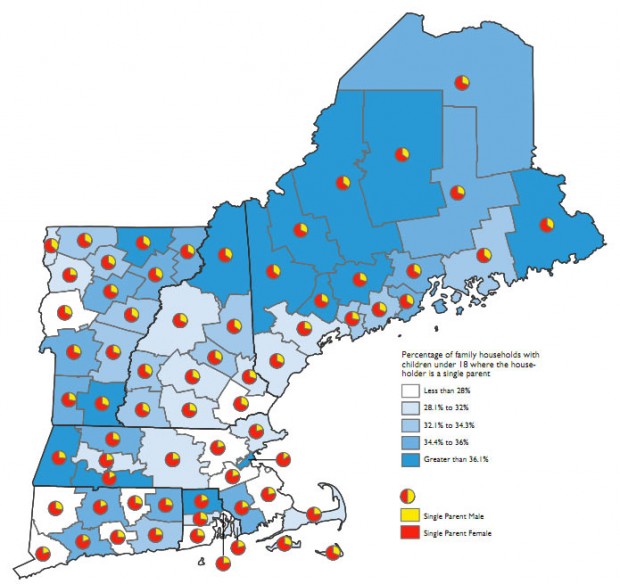In New Hampshire, One County Claims Highest Proportion Of Woman-Headed Families
Nearly one-third of New England families with children are single-parent households. That’s according to a map published in Communities And Banking, a quarterly publication released by the Boston Fed. Using Census data, Robert Clifford mapped out the percentage of New England households that were single families. He also notes with pie charts the proportion that are single mothers vs. single fathers.

zacharmstrong / Flickr
2010 Census data shows that in New England, single-parent households are still primarily headed by women.
Overall, New Hampshire counties appear to skew low on the single-parent family count. Among the major population centers, Rockingham County reports the fewest single-family households, settling below the 28 percent mark. Meanwhile, Hillsborough and Merrimack Counties report 28.1-32 percent single-parent homes. Less populated Grafton and Belknap Counties fall into the same range as Hillsborough and Merrimack.
Cheshire, Sullivan, Belknap and Carroll Counties claim the next highest proportion of single-parent households, hovering between 32.1 and 34.3 percent.
New Hampshire then skips the next-highest bracket altogether, with Coos County claiming the highest portion: More than 36.1 percent of families there are single-parent households.
Here’s how Clifford’s analysis reads:
“The U.S. Census Bureau’s 2010 decennial census reports 34.7 million families
nationwide with children under the age of 18, of which 32.1 percent (11.2
million) were single-parent households. Of the 1.6 million New England
families with children under age 18, nearly 30.9 percent (4.9 million) were
single-parent households. Although a high share of single-parent families may
be seen in urban areas, there are similarly high concentrations in rural areas
of Maine, Vermont, and New Hampshire.
Single-parent heads of households are mostly female, but differences exist
between urban and rural counties. Counties with the largest shares of singlefather
households tend to be in northern New England, with the highest in
Vermont’s Grand Isle County and Maine’s Hancock and Oxford counties.”
Share of Families with Children under Age 18 That Are Single-Parent Households, by County

Robert Clifford / Federal Reserve Bank of Boston
Note: “Family households” consist of a householder and one or more other people related to
the householder by birth, marriage, or adoption. They do not yet include same-sex married
couples. The share of families with children under age 18 that are single-parent households
is the sum of such households that were reported as “male householders, no wife present”
and “female householder, no husband present” in the 2010 decennial census—divided by the
universe of such households.
So what’s the economic state of single moms, grandmothers, and other women raising kids alone in Coos County?
Since the US Census Bureau is still crunching 2010 numbers and working them up into usable forms, StateImpact decided to check out the most recent, analyzed data available from the Bureau. And that’s the 2005-2009 American Community Survey estimates.
According to the survey, among all families with kids under 18 years old, about 14.7 percent fell below the poverty level.* When you only count families with very young kids–under five years old–that number shoots up to 23.9 percent. In other words, the Census Bureau estimated in 2009 that more than one out of seven Coos County families with kids fell below the poverty line. And nearly a quarter of families with kids under five lived in poverty. That’s compared to the statewide poverty rate of 8.1 percent for all families with kids under 18, and 10.6 percent for families with kids under five.
And the county’s poverty rate numbers went up dramatically when the only provider was a woman. For families with kids younger than 18 years old, the poverty rate was 41.8 percent. And if the woman is taking care of kids under five years old, once again, the number shoots up, to 58.8 percent.
*That number includes numerous permutations of the term “family,” beyond the married couple, single mother or single father set-up. When you count just married couples, the poverty rate is much lower, at 3.4 percent. The married couple rate remains low even when adding children to the equation, at 3.2 percent for families with kids under 18 years old, and 1.4 percent for families with children younger than five.
